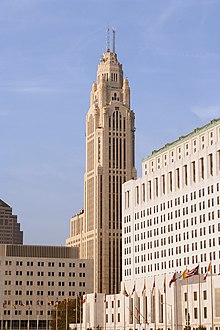C. Howard Crane
This article includes a list of general references, but it lacks sufficient corresponding inline citations. (November 2013) |
C. Howard Crane | |
|---|---|
| Born | Charles Howard Crane August 13, 1885 Hartford, Connecticut, U.S. |
| Died | August 15, 1952 (aged 67) |
| Nationality | American |
| Occupation | Architect |

Charles Howard Crane (August 13, 1885 – August 14, 1952) was an American architect who was primarily active in Detroit, Michigan. His designs include Detroit's Fox Theatre and Olympia Stadium, as well as LeVeque Tower in Columbus, Ohio, which remains that city's second tallest building.
Biography
[edit]
Born in Hartford, Connecticut, Crane moved to Detroit in 1904.[1] He worked as a draftsman for several architectural firms, including Albert Kahn Associates, Smith, Hinchman & Grylls, and the office of Gustave A. Mueller, before opening his own office in 1908.[1][2]
Like Thomas W. Lamb and John Eberson, Crane specialized in the design of movie palaces in North America.[3] Crane's career would include some 250 theaters in total, with 62 of them in the Detroit area. His 5174-seat Detroit Fox Theatre was the largest of the Fox Theatres. The 4,500 seat Fox Theatre in St. Louis was its slightly smaller architectural near twin. These were considered to have been his architectural masterpieces. Among the five massive Fox theatres, Crane also designed the Brooklyn Fox (4,088 seats, razed).
Crane also designed Olympia Stadium (Detroit Olympia), which eventually had seating for 13,375 plus standing room for 3,300. Olympia, used by the Detroit Red Wings, was razed in 1987.
Crane also designed many office buildings. Most of his many downtown Detroit movie palaces had attached office towers that he designed (the Fox, United Artists, State, Capitol). However, Crane's office tower masterpiece is the 47 story 555 ft. tall LeVeque Tower in Columbus, Ohio.
Due to the 1929 Great Depression, Crane's theatre and office building commissions dried up. He became disillusioned and in 1930 moved to London, England,[1] although he kept his Detroit office open for many years after moving.[3] Crane designed many cinemas across Britain, but in much tamer designs than his American movie palaces.
Crane's most famous U.K. commission was Earls Court Exhibition Centre, an Art Moderne convention center that opened in 1937. It closed in 2014 and was demolished between 2015 and 2017.
Crane returned to visit Detroit once or twice a year until World War II. He then remained in London, where he died and was buried in 1952. His namesake descendants (C. Howard Crane III, et al.) now live in the Detroit area.[citation needed][relevant?]
Crane-designed buildings
[edit]
- All buildings are located in Detroit, unless otherwise indicated.
- Majestic Theatre, 1915
- Liberty/Paramount Theatre, Youngstown, Ohio, 1918
- The Metropolitan, Winnipeg, Manitoba, Canada, 1919
- Orchestra Hall, 1919
- Old Walkerville Theatre, Walkerville, Ontario, Canada, 1920
- Macomb Music Theatre, Mount Clemens, Michigan, 1921
- Palace Theatre, Calgary, Alberta, Canada, 1921
- Virginia Theatre, Champaign, Illinois, 1921
- Detroit Opera House, 1922
- Temple Beth-El conversion to theatre, 1922
- World Theater, Omaha, Nebraska, 1922, renamed in 1935 to Omaha Theater, razed in 1980
- Detroit Institute of Arts (as consulting architect), 1923–27
- Lafayette Building, 1923 (razed, 2010)
- Warner Theatre (formerly the Earle Theatre), Washington, D.C., 1924
- August Wilson Theatre (formerly the Guild Theatre and the Virginia Theatre), New York City, 1925
- The Fillmore Detroit (formerly the State Theatre), 1925
- Film Exchange Building, 1926
- Detroit Olympia, 1927 (home to the Detroit Red Wings until 1979; razed, 1987)
- United Artists Theater, Los Angeles, 1927
- LeVeque Tower, Columbus, Ohio, 1927
- United Artists Theatre Building, 1928
- Fox Theatre, 1928
- Fox Theatre, St. Louis, 1929
- Earls Court Exhibition Centre, London, England, 1937 (demolished 2014)
- Vickers-Armstrongs (Aircraft) Ltd headquarters, Brooklands, Weybridge, England, 1938
See also
[edit]References
[edit]- ^ a b c Hill, Eric J.; John Gallagher (2002). AIA Detroit: The American Institute of Architects Guide to Detroit Architecture. Wayne State University Press. ISBN 0-8143-3120-3. pp. 345–346.
- ^ DiChiera, Lisa Maria (1992). The Theater Designs of C. Howard Crane (Masters Thesis). University of Pennsylvania. pp. 9–11.
- ^ a b Sullivan, Taryn. C. Howard Crane. Historic Detroit. Retrieved on November 9, 2013.
Further reading
[edit]- Hauser, Michael; Marianne Weldon (2006). Downtown Detroit's Movie Palaces (Images of America). Arcadia Publishing. ISBN 0-7385-4102-8.
- Meyer, Katherine Mattingly and Martin C.P. McElroy with Introduction by W. Hawkins Ferry, Hon A.I.A. (1980). Detroit Architecture A.I.A. Guide Revised Edition. Wayne State University Press. ISBN 0-8143-1651-4.
{{cite book}}: CS1 maint: multiple names: authors list (link) - Perkins, Michael A. (2005). Leveque: The First Complete Story of Columbus' Greatest Skyscraper. AuthorHouse. ISBN 978-1420802948.
- Sharoff, Robert (2005). American City: Detroit Architecture. Wayne State University Press. ISBN 0-8143-3270-6.

